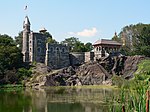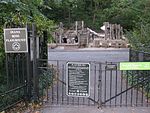The Tempest (Hebald)
1966 establishments in New York City1966 sculpturesAC with 0 elementsBronze sculptures in Central ParkNew York (state) sculpture stubs ... and 8 more
New York City stubsOutdoor sculptures in ManhattanSculptures in Central ParkSculptures of men in New York CitySculptures of women in New York CityStatues in New York CityStatues of fictional charactersWorks based on The Tempest

The Tempest, also known as The Tempest (Prospero and Miranda), or simply Prospero and Miranda, is an outdoor bronze sculpture depicting Prospero and Miranda from William Shakespeare's The Tempest by Milton Hebald, installed outside Delacorte Theater in Manhattan's Central Park, in the U.S. state of New York. The work, which was donated by George T. Delacorte, Jr. and unveiled in 1966, is a companion piece to Romeo and Juliet (1977).
Excerpt from the Wikipedia article The Tempest (Hebald) (License: CC BY-SA 3.0, Authors, Images).The Tempest (Hebald)
West Drive, New York Manhattan
Geographical coordinates (GPS) Address Website Nearby Places Show on map
Geographical coordinates (GPS)
| Latitude | Longitude |
|---|---|
| N 40.78014 ° | E -73.96879 ° |
Address
Delacorte Theater
West Drive
10024 New York, Manhattan
New York, United States
Open on Google Maps










